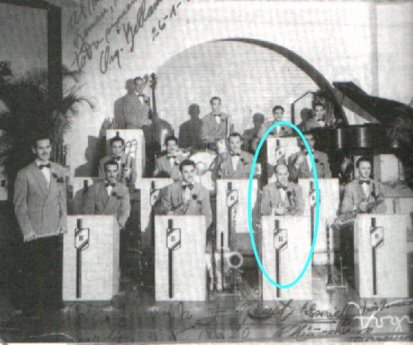10.4.1 Jazz Bands in Cuba until 1958.

The Jazz Band is an instrumental format originating from American music, consisting of piano, double bass, drums, conga drum, saxophone, trumpets, and trombones. It was introduced in Cuba as a result of the influence of North American music; in our country, the format has expanded to include Cuban percussion instruments such as the bongo, maracas, and güiro.
In 1929, the first big band in Cuba called “Hermanos Castros” was formed under the direction of saxophonist Manolo Castro, which included brass, saxophone, and percussion sections.
The 1930s were a golden age for Cuban music worldwide, with the birth of several important big bands, including Los Curbelo, Havana Casino, Lecuona Cuban Boys, and Riverside. The Armando Romeu groups that followed featured arrangers and musicians such as Chico O’Farril, Pucho Escalante, Bebo Valdés, Peruchín Justiz, Kiki Hernández, Isidro Pérez, Gustavo Más, Rafael Tata Palau, Pedro Chao, and Armando Romeu himself.
At the beginning of the 1940s, Cuban music achieved resounding worldwide success, and a fusion of jazz and Afro-Cuban music took place in New York City. Meanwhile, in Havana during these years, another historic jazz band, “La Bellamar,” also led by Armando Romeu, emerged. It featured trumpeter Luis Escalante, trombonist Leopoldo Pucho Escalante, and tenor saxophonist Gustavo Más, all of whom became top-tier jazz musicians. When this band dissolved, its director was hired by the Tropicana cabaret (4504 Calle 72, Marianao, Havana), where he created a robust band of four trumpets, three trombones, and five saxophones, which included musicians such as Peruchín Justiz, Isidro Pérez, Kiki Hernández, and Daniel Pérez. This group was considered by critics at the time to be the best rhythm section in a Cuban jazz band.
Other distinguished jazz bands of this era included the Palau Brothers, the Lebatard Brothers, and Casino de la Playa. The latter group featured, among others, the popular singer Orlando Guerra “Cascarita” and the pianist and arranger Dámaso Pérez Prado, who later became known as the King of Mambo.
The 1950s were not characterized musically by a break from the previous decade, but the mafia’s attempt to turn Havana into a city like Las Vegas resulted in unprecedented growth in show business with the construction of new hotels and small nightclubs where jazz sessions were often organized. The Tropicana cabaret (4504 72nd Street, Marianao, Havana) became the center of Cuban jazz. Armando Romeu’s band contributed greatly to the cabaret, as its drummer Guillermo Barreto organized the historic jazz sessions there every Sunday, featuring Alejandro “El Negro Vivar” on trumpet; Tata Palau on tenor saxophone; Bebo Valdés on piano; and Fernando Vivar on double bass.
During those years, the first jazz LP was recorded in Cuba, titled “Cubano,” a Norman Granz production featuring musicians such as El Negro Vivar, Gustavo Más, Bebo Valdés, Kiki Hernández, Guillermo Barreto, and Rolando Alfonso. From 1957 to 1959, the albums “Descargas” or Cuban Jazz Sessions were recorded, featuring musicians such as Peruchín Justiz, Walfredo de los Reyes, Marcelino Valdés, and Arístides Soto (Tata Güines), among others.








